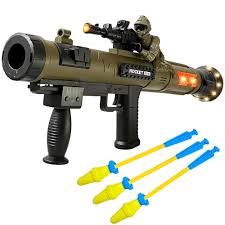There’s something magical about watching a rocket shoot into the sky, even if it’s only made of foam and powered by air. For kids (and honestly, plenty of adults), a rocket toy launcher is more than just a plaything — it’s a gateway to science, creativity, and hours of outdoor fun. If you’ve ever wondered whether one of these gadgets is worth adding to your backyard, classroom, or gift list, this guide is for you.
What Is a Toy Rocket Launcher?
A toy rocket launcher is a kid-friendly device that launches small rockets into the air, usually powered by air pressure, water, or a stomp pad. Unlike professional model rockets that use combustible engines, toy launchers are designed to be safe, reusable, and fun for younger age groups.
There are three main types you’ll find in stores or online:
- Foam or air-pump launchers — soft rockets that fly when compressed air is pumped into them.
- Stomp rockets — the most popular kind, where kids stomp on an air bladder to propel the rocket skyward.
- Water rockets — slightly more advanced, using water and air pressure to achieve impressive heights.
Each type has its pros and cons, but all of them are about combining fun with a little science in action.
Why Kids (and Parents) Love Them
rocket toy launcher strike the perfect balance between excitement and education. They’re simple enough for children to use but fascinating enough to keep adults engaged, too.
- Active play: Stomping, running, and chasing rockets beats another hour on a tablet.
- STEM learning: Concepts like air pressure, force, and gravity come alive in the backyard.
- Social fun: Launchers make great group activities for birthdays, science fairs, or family BBQs.
- Affordable thrills: Most stomp rocket sets cost less than a video game and last for years.
As one parent described it: “It’s the rare toy where my 6-year-old, 10-year-old, and even my husband compete for turns.”
The Science Behind the Whoosh
Here’s the cool part: every launch is a mini physics lesson.
- Air-powered rockets use compressed air to push the rocket upward. The harder the stomp, the greater the force.
- Water rockets rely on Newton’s Third Law of Motion: the water rushing down pushes the rocket up.
- Foam rockets with fins demonstrate aerodynamics — a well-balanced rocket flies straighter and higher.
Even if kids don’t realize it, they’re learning about motion, energy, and cause-and-effect every time they launch. Teachers often use toy rocket launchers as simple classroom experiments because the science is visible and exciting.
Choosing the Right Toy Rocket Launcher
Not all rocket toy launcher are created equal. Here are factors to consider before buying one:
- Age range:
- Ages 3–6: Foam rockets with soft tips are safest.
- Ages 6–10: Stomp rockets — durable, energetic, fun.
- Ages 8+: Water rockets, with adult supervision.
- Durability: Look for sturdy launch pads and rockets made from quality foam or plastic. Cheap sets may break after a few launches.
- Height: Stomp rockets can reach 100–200 feet, while water rockets may soar even higher. If you have a small yard, you may prefer a lower-range launcher.
- Replacement rockets: Kids will lose rockets in trees, roofs, or neighbor’s yards. Check that replacements are available.
- Extra features: Some sets include glow-in-the-dark rockets, LED lights, or adjustable launch angles. These can add fun variety.
Safety First: How to Launch Without Worry
Even the safest toy can cause problems if used carelessly. Here are some golden safety rules:
- Launch in open spaces. Avoid power lines, roads, or crowded areas.
- Never aim at people or pets. Rockets should always point skyward.
- Use goggles with water rockets. Pressurized launches carry more force.
- Supervise younger kids. Especially important for water-based launchers.
- Check the equipment. Inspect for cracks, leaks, or sharp edges before launching.
Think of it like this: toy rockets are safe when treated as science experiments, not squirt guns.
Real-World Fun: A Family Example
At a neighborhood block party last summer, one family brought a stomp rocket kit. Within minutes, kids aged 4 to 12 lined up to stomp, shout, and chase foam rockets across the lawn. Parents cheered. Even grandparents took turns. By the end of the day, they had organized a contest to see who could send their rocket the highest.
The toy cost under $25, but the laughter and bonding were priceless. As one dad joked: “Forget the grill — this stomp rocket was the hit of the party.”
How Toy Rocket Launchers Spark STEM Learning
The buzz around STEM (science, technology, engineering, math) education isn’t just for classrooms. Toy rocket launchers give kids a hands-on way to explore:
- Hypothesis testing: What happens if I stomp harder?
- Variables: How does rocket angle change the flight path?
- Measurement: Can I track how high it goes or how far it travels?
- Problem-solving: Why did it tilt? How can I adjust the fins?
These simple activities encourage critical thinking while still feeling like play.
DIY Rocket Launcher Idea (Simple and Safe)
Want to add creativity to playtime? Try building a simple DIY launcher with your kids.
Materials:
- 2-liter plastic bottle
- Foam rocket (store-bought or homemade with pool noodles)
- PVC pipe or a flexible plastic tube
- Duct tape
Steps:
- Insert the tube into the bottle’s neck and seal with duct tape.
- Place the rocket on the other end of the tube.
- Squeeze or stomp on the bottle — blastoff!
This version doesn’t reach crazy heights, but it’s safe, cheap, and fun to build together.
Storing and Maintaining Your Launcher
Like any toy, a little care extends the life of your rocket toy launcher:
- Rinse water rockets after use to prevent mildew.
- Store foam rockets indoors to prevent sun damage.
- Replace worn launch pads or tubes if they crack.
- Keep everything in one container — rockets have a sneaky way of disappearing.
Eco-Friendly Play
Worried about waste? Many rocket toy launcher kits use foam and lightweight plastic, but you can make eco-friendly choices:
- Pick brands that offer biodegradable foam rockets.
- Collect lost rockets after every play session.
- Reuse water bottles for DIY launchers instead of throwing them out.
Play and planet-friendly can go hand in hand.
Final Thoughts: Why a Toy Rocket Launcher Is Worth It
A rocket toy launcher is more than just a fun gift. It’s a way to get kids outdoors, spark their curiosity about science, and create shared memories that last longer than any rocket flight. Whether it’s a stomp rocket in the backyard, a water rocket at summer camp, or a foam rocket for rainy-day science lessons, these toys deliver excitement and learning in one package.
So, if you’re looking for a toy that makes kids squeal, parents smile, and neighbors peek over the fence, you can’t go wrong with a rocket launcher. Just remember: clear skies, safe space, and plenty of stomps.
Because sometimes, the best way to inspire young minds is simply to let them launch. 🚀






